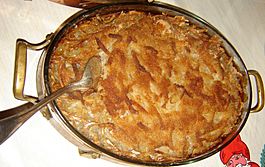Jansson's temptation facts for kids
 |
|
| Type | Casserole |
|---|---|
| Place of origin | Sweden |
| Main ingredients | Potatoes, onions, pickled sprats, bread crumbs, cream |
Jansson's temptation (called Janssons frestelse in Swedish) is a super yummy and traditional Swedish casserole. It's made with potatoes, onions, special pickled fish called sprats, bread crumbs, and rich cream.
This dish is a big hit during Swedish holidays. You'll often find it on a Christmas julbord (Christmas buffet) or an Easter påskbuffé (Easter buffet). It's also very popular in Finland, where it's known as janssoninkiusaus.
How to Make Jansson's Temptation
Making Jansson's temptation is quite simple! First, you cut potatoes into thin strips. Then, you layer them in a baking dish. You add layers of the pickled sprats and chopped onions in between the potato layers.
You sprinkle a little salt and pepper over each layer. After that, you pour in cream until it almost fills the dish. Finally, you bake it in an oven at about 200 degrees Celsius (390°F) for around one hour. This makes the potatoes soft and the top golden brown.
Sprats vs. Anchovies
Sometimes, recipes for Jansson's temptation get a bit mixed up in English. They might say to use anchovies instead of sprats. This can be confusing! In Sweden, the small fish called sprats (Sprattus sprattus) that are pickled with sugar, salt, and spices have been known as ansjovis since the mid-1800s.
However, the true anchovies (Engraulis encrasicolus) are sold in Sweden as sardeller. So, when a Swedish recipe says ansjovis, it usually means these special pickled sprats, not the anchovies you might be thinking of. Sometimes, small herring fish can also be used instead of sprats.
The Story Behind the Name
The name "Jansson's temptation" has an interesting history. Many people used to think it was named after a famous opera singer named Per Adolf "Pelle" Janzon (1844–1889). He was known for loving good food!
However, another story about the name's origin is quite popular. A writer named Gunnar Stigmark (1910–2001) wrote an article about it. He said the name came from a silent film called Janssons frestelse (1928). This film starred an actor and director named Edvin Adolphson.
According to Stigmark, his mother and her chef came up with the name for this dish. They made it for a special dinner party. The name stuck, and soon, other families started calling it Jansson's temptation too. Eventually, it even appeared in cookbooks!
See also
 In Spanish: Janssons frestelse para niños
In Spanish: Janssons frestelse para niños


